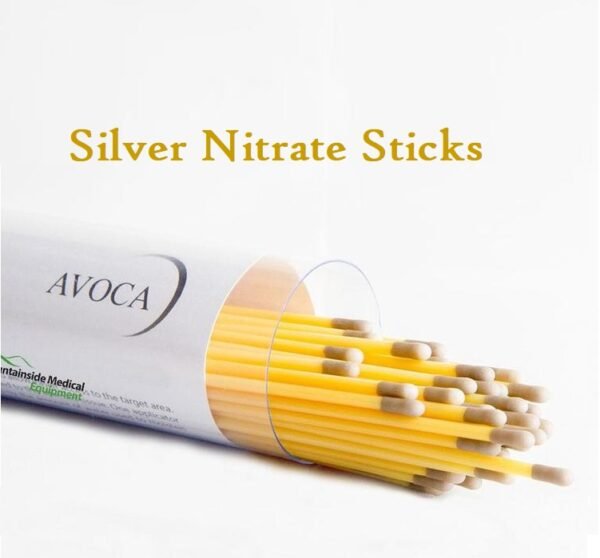By precipitating bacterial proteins, silver nitrate prevents bacterial reproduction. It is used as an antibacterial, cauterising agent, and to remove warts, corns, and granulation tissues from wounds.
Silver nitrate Uses:
- It is used as an astringent, to cauterise wounds, as a germicidal, and to remove warts, corns, and granulation tissue.
Silver Nitrate Dose in Adults
Silver Nitrate Dose as an antiseptic and for wound cauterization: Topical:
If you're using silver nitrate as an antiseptic or for wound cauterization (burning to stop bleeding or treat tissue), here's how you might use it:
- For sticks: Only put it on the parts of your body that are wet, like inside your mouth or on moist skin. Apply it only where needed.
- For a solution: Soak a cotton swab or applicator with the solution and gently put it on the affected area. Do this 2-3 times a week for 2-3 weeks.
Remember, it's important to follow these instructions carefully and not use more than directed.
Silver Nitrate Dose in Children
Dose of silver nitrate for wound cauterization, degranulation of tissues (warts, corns), and antimicrobial purposes:
For using silver nitrate as an antiseptic, for wound cauterization, or for treating tissue degranulation (like warts or corns) in children and adolescents:
- For sticks: Put it only on the parts of the body that are wet, like inside the mouth or on moist skin. Apply it only where needed.
- For a solution: Dip a cotton swab or applicator into the solution and gently apply it to the affected area. Do this 2 to 3 times a week for 2 to 3 weeks.
Keep in mind, the way you apply it and how often you use it might be different depending on what you're treating.
Pregnancy Risk Category: C
No animal or human pregnancy studies have been carried out. It may be used with caution in pregnant or lactating women.
Silver nitrate Dose in kidney disease:
No dosage adjustment recommended.
Silver nitrate Dose in Liver disease:
No dosage adjustment recommended.
Side effects of Silver Nitrate:
- Hematologic & oncologic:
- Methemoglobinemia
- Dermatologic:
- Skin irritation
- Burning Sensation of Skin
- Skin discolouration
Contraindications to Silver Nitrate:
- If you have a hypersensitivity (allergic reaction) to silver nitrate or any part of the product, you shouldn't use it.
- Also, don't use it on broken skin, cuts, or wounds.
- It's important to avoid using it if you're allergic to it or if it might worsen an existing injury.
Warnings and precautions
Chemical burn
- Silver nitrate can cause chemical burns if it's not used correctly.
- It's important to be very careful, especially with delicate skin like that of newborns or thin skin.
- When using applicator sticks, make sure the contact time with the skin is very short to avoid harm.
- Always handle it with caution and follow the instructions carefully to prevent any injuries.
Skin discoloration:
- Using silver nitrate for a long time might lead to changes in skin color.
- This means your skin might look different where you've applied the silver nitrate regularly.
- To avoid this, it's essential to use it only as directed and for the recommended duration.
Silver nitrate: Drug Interaction
|
Risk Factor C (Monitor therapy) |
|
|
BCG Vaccine (Immunization) |
The therapeutic benefit of the BCG vaccine may be reduced by antibiotics. |
|
Risk Factor D (Consider therapy modification) |
|
|
Sodium Picosulfate |
Antibiotics may reduce Sodium Picosulfate's therapeutic impact. Management: If a patient previously used or is currently using an antibiotic, think about utilising an alternate product for bowel cleaning prior to a colonoscopy. |
|
Risk Factor X (Avoid combination) |
|
|
BCG (Intravesical) |
Antibiotics may diminish the therapeutic effect of BCG (Intravesical). |
Monitoring Parameters:
None mentioned.
How to administer Silver Nitrate?
Using Applicators Safely:
- Avoid Ophthalmic Use: Don't use the applicator sticks for your eyes. They're meant for other areas of the body, not the eyes.
- Keep Skin Moist: If you're using the sticks on dry skin, dip the tip of the applicator in water right before using it. This helps prevent any irritation or damage to your skin.
Mechanism of action of Silver Nitrate:
- Silver ions, which are released from silver nitrate, can bind with chloride in tissues, forming silver chloride.
- This process causes bacterial proteins to precipitate, effectively inhibiting the growth of both gram-positive and gram-negative bacteria.
- Additionally, silver ions can coagulate cellular proteins, leading to the formation of a protective layer called an eschar.
- This mechanism is believed to be how silver nitrate helps control conditions like benign hematuria (blood in urine), rhinitis (inflammation of the nose), and recurrent pneumothorax (collapsed lung).
- The ability of silver nitrate to precipitate bacterial proteins and form an eschar contributes to its antimicrobial and therapeutic properties in these conditions.
Excretion:
- As for excretion, the highest amounts of silver are typically found in the kidneys during autopsy examinations.
- However, only a small amount of silver is excreted in the urine.
- This means that most of the silver is retained in the body rather than being eliminated through urine.
Absorption:
- When it comes to absorption, the silver ions in 0.5% and 1% silver nitrate preparations don't absorb much through the gastrointestinal (GI) tract or the skin.
- This is because these ions quickly bind with proteins, limiting their absorption.
International Brand Names of Silver nitrate:
- Mova Nitrat Pipette
Silver nitrate Brand Names in Pakistan:
No Brands Available in Pakistan.







